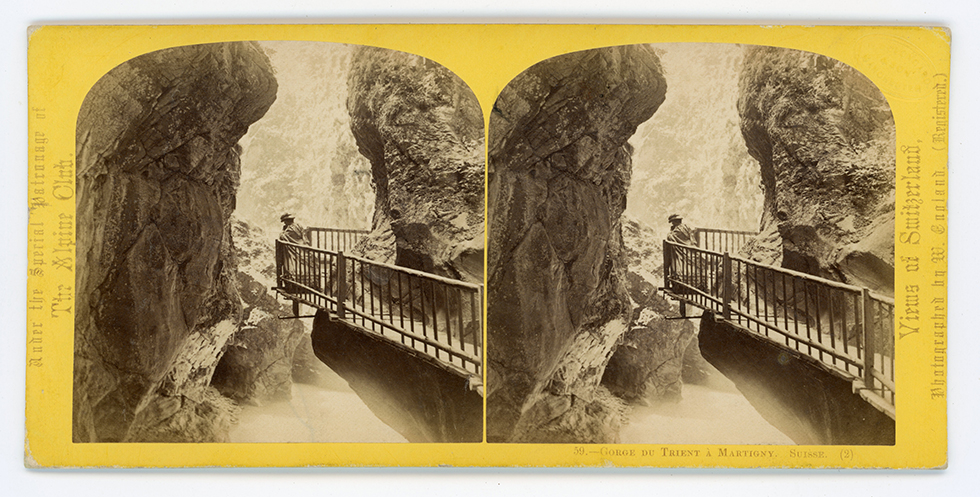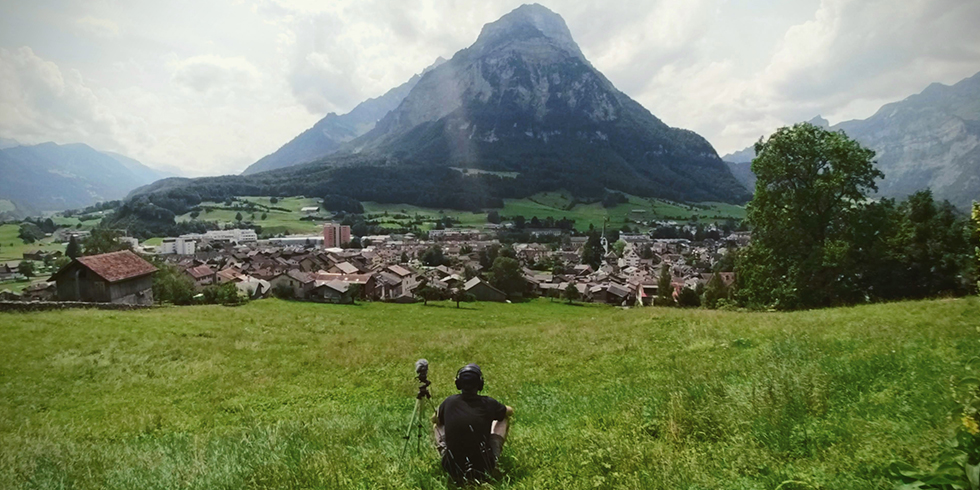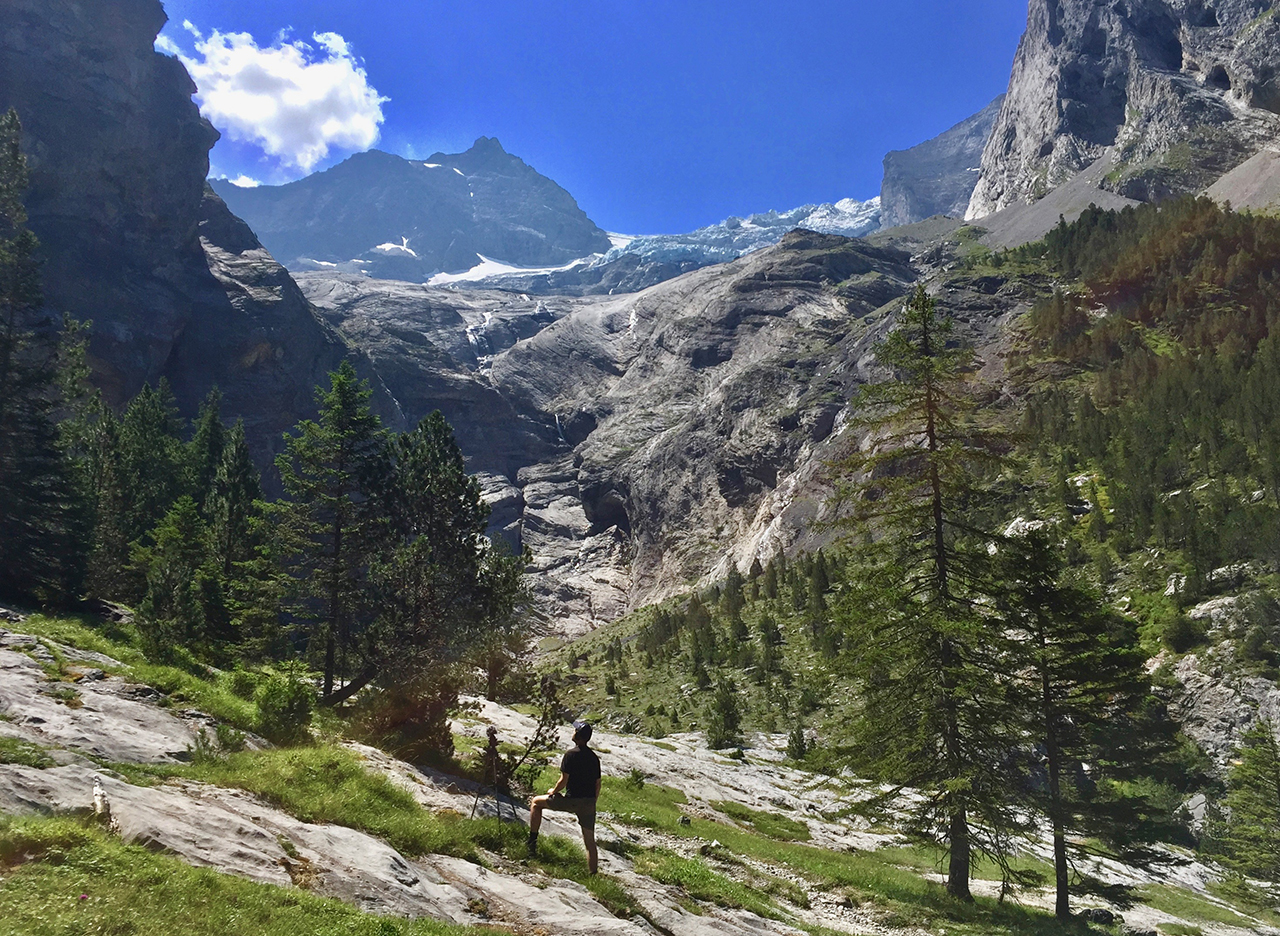ABOUT
(What does “binaural” mean? Click here.)
Binaural Views of Switzerland is an audio-visual observation of the changes caused by human activity in the Swiss Landscape since 1863, when the pioneering British photographer William England made his Grand Tour of Switzerland, creating stunning stereoscopic photographs of over 150 locations.
Artist Alan Alpenfelt, over a two month journey, has re-discovered 30 of these locations, documenting the changes in their aspects and atmospheres, re-presenting them in his exhibition, using binuaral sound recording and 3D photography.
His work highlights the stark contrasts between past and present by immersing the visitor in the sights and sounds of each environment, then and now.
A particularly immersive experience within the exhibition, is a Kaiser Panorama, which features the stereoscopic photographs linked to headphones through which the visitor can choose between the contrasting binaural soundscapes of the present day or the imagined ones of the past.
Awareness of the effects of mass tourism, modern transport, climate change and industrial development pervades the exhibition, stimulating questions as to how resilience and conservation can somehow still be achieved: which places remain intact and which ones have suffered such deep changes that they are in need of new narratives to justify them.
︎Scroll for more information on the project
Binaural Views of Switzerland is an audio-visual observation of the changes caused by human activity in the Swiss Landscape since 1863, when the pioneering British photographer William England made his Grand Tour of Switzerland, creating stunning stereoscopic photographs of over 150 locations.
Artist Alan Alpenfelt, over a two month journey, has re-discovered 30 of these locations, documenting the changes in their aspects and atmospheres, re-presenting them in his exhibition, using binuaral sound recording and 3D photography.
His work highlights the stark contrasts between past and present by immersing the visitor in the sights and sounds of each environment, then and now.
A particularly immersive experience within the exhibition, is a Kaiser Panorama, which features the stereoscopic photographs linked to headphones through which the visitor can choose between the contrasting binaural soundscapes of the present day or the imagined ones of the past.
Awareness of the effects of mass tourism, modern transport, climate change and industrial development pervades the exhibition, stimulating questions as to how resilience and conservation can somehow still be achieved: which places remain intact and which ones have suffered such deep changes that they are in need of new narratives to justify them.
︎Scroll for more information on the project






Team
Journey and sound recording: Alan Alpenfelt.Kaiser Panorama: Franco Mondia & Antonio Lo Menzo.
Soundscape creations: Enrico Mangione.
A project by: Alan Alpenfelt.
Special thanks to: London Stereoscopic Company and Peter Blair for providing information on William England.
Sustained by: ProHelvetia, FSRC/SRKS, Oertli Stiftung.


William ENGLAND
His 1863 journey through Switzerland
During the Summer of 1863, photographer William England, today one of the most overlooked photographic geniuses of Great Britain, undertook a stunning journey through Switzerland. He documented and photographed places of unmatched beauty, producing more than 1000 stereoscopic photographs of Swiss nature and urban landscapes.
British pioneers were at the forefront of alpinism, discovering mountain peaks and glaciers only locals had known of before.
William’s journey coincided with the end of the little ice age - which began in the XVI century - giving him the unique opportunity to photograph the maximum extensions of the glaciers and other environments which have in part or entirely disappeared today. His legacy is a remarkable source of detailed information for comparison with the present day.
William England had many competitors who were embracing the new idea of promoting tourism through landscape photography. But William had a photographic eye others didn’t possess.
He didn’t just take the shot: he knew that it was necessary to include a story in order to make a commercial success of his photography. Something was needed to stimulate the imagination of the viewer; so, while travelling, he’d bring his wife and helpers along to model for him. He would position them so that the images depicted would combine the spectacular with the romantic, appealing to the subconscious need to escape from the ordinary while suggesting that the experience was possible for everyone. Travellers could now reach the most dazzling locations, even view the soaring peaks of Switzerland.
William’s impressive creations ran parallel to the romantic trends in art and literature of the time, making him one of the most popular photographers of his day.
In the same period, transport was being revolutionized, offering the public, especially the new bourgeoisie, the possibility to reach the faraway places of their dreams.
British pioneers were at the forefront of alpinism, discovering mountain peaks and glaciers only locals had known of before.
William’s journey coincided with the end of the little ice age - which began in the XVI century - giving him the unique opportunity to photograph the maximum extensions of the glaciers and other environments which have in part or entirely disappeared today. His legacy is a remarkable source of detailed information for comparison with the present day.
William England had many competitors who were embracing the new idea of promoting tourism through landscape photography. But William had a photographic eye others didn’t possess.
He didn’t just take the shot: he knew that it was necessary to include a story in order to make a commercial success of his photography. Something was needed to stimulate the imagination of the viewer; so, while travelling, he’d bring his wife and helpers along to model for him. He would position them so that the images depicted would combine the spectacular with the romantic, appealing to the subconscious need to escape from the ordinary while suggesting that the experience was possible for everyone. Travellers could now reach the most dazzling locations, even view the soaring peaks of Switzerland.
William’s impressive creations ran parallel to the romantic trends in art and literature of the time, making him one of the most popular photographers of his day.
In the same period, transport was being revolutionized, offering the public, especially the new bourgeoisie, the possibility to reach the faraway places of their dreams.
 View on Rosenlaui Glacier, near Rosenlaui Hotel in Canton Bern (1863)
View on Rosenlaui Glacier, near Rosenlaui Hotel in Canton Bern (1863)The photo was sligthly tilted to the right to make the ground look steeper than it actually is. Underneath, the same place today, with the same degree of tilt, but with, sadly, a considerably lower amount of ice.

Same view of the Rosenlaui Glacier today, 2019.
Alan alpenfelt
His 2019 journey tracing the steps of William England.
To find out what the locations photographed by William England look like today, but also to understand what it meant to travel through a difficult landscape when public transport was in its infancy, Alan chose 30 locations to visit, selecting a balance between cities, mountains, valleys, lakes and cultural symbols. He was able to contrast the two journeys through his use of the highly environmentally friendly modern Swiss public transport system.
Visiting the locations and confronting the stereoscopic photographs with present day views, it was possible to observe environmental changes over the last 150 years. Some places have changed radically, others less. There are changes that national and local politics can do very little about because they are caused by global processes (for example the melting of glaciers). Others instead, for example, cities and villages, have remained nearly intact thanks to the special care taken in Switzerland to preserve tradition and history.
Follow this link to see the locations of the journey. or check out the map!
Fieldrecording & Radio Drama
 Walking up to Aescher - Wildkirchli, Canton Appenzell.
Walking up to Aescher - Wildkirchli, Canton Appenzell.In each location Alan recorded the sounds, in mono/stereo and binaurally, for the visitor to listen to, through headphones, at the exhibition. The photographed environments, accompanied by their corresponding modern-day soundscapes, create a fully immersive experience.
He has also recreated the sounds of what the same environments might have sounded like in 1863; this gives the public the unique chance to “travel through time”, through the use of a mixer, from the sounds of today to those of the past.
William England’s experience is also recorded in a radio drama in which he uses the sounds recorded on the journey alternated by interviews and conversations with experts on the themes associated with romantic photography and its connection to the promotion of world tourism.
He has also recreated the sounds of what the same environments might have sounded like in 1863; this gives the public the unique chance to “travel through time”, through the use of a mixer, from the sounds of today to those of the past.
William England’s experience is also recorded in a radio drama in which he uses the sounds recorded on the journey alternated by interviews and conversations with experts on the themes associated with romantic photography and its connection to the promotion of world tourism.
Google maps


Stereoscopic touristic landscape photography can be considered – arguably - the beginning of what would one day become smart phone 3D photography and social network exchange. Using filters and special effects, today’s tourists can try and capture the essence of an emotional travel experience and share it worldwide. In a modern-day tribute to William England’s stereoscopic documentation, Alan has placed every location he visited and photographed on Google Street View, creating a kind of “treasure map” for the visitor to enjoy.
Follow this link to see the locations of the journey.
Follow this link to see the locations of the journey.


